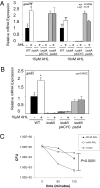Chemical sensing in mammalian host-bacterial commensal associations
- PMID: 20457895
- PMCID: PMC2906910
- DOI: 10.1073/pnas.1002551107
Chemical sensing in mammalian host-bacterial commensal associations
Erratum in
- Proc Natl Acad Sci U S A. 2010 Jul 13;107(28):12734
- Proc Natl Acad Sci U S A. 2010 Jun 8;107(23):10765
Abstract
The mammalian gastrointestinal (GI) tract is colonized by a complex consortium of bacterial species. Bacteria engage in chemical signaling to coordinate population-wide behavior. However, it is unclear if chemical sensing plays a role in establishing mammalian host-bacterial commensal relationships. Enterohemorrhagic Escherichia coli (EHEC) is a deadly human pathogen but is a member of the GI flora in cattle, its main reservoir. EHEC harbors SdiA, a regulator that senses acyl-homoserine lactones (AHLs) produced by other bacteria. Here, we show that SdiA is necessary for EHEC colonization of cattle and that AHLs are prominent within the bovine rumen but absent in other areas of the GI tract. We also assessed the rumen metagenome of heifers, and we show that it is dominated by Clostridia and/or Bacilli but also harbors Bacteroidetes. Of note, some members of the Bacteroidetes phyla have been previously reported to produce AHLs. SdiA-AHL chemical signaling aids EHEC in gauging these GI environments, and promotes adaptation to a commensal lifestyle. We show that chemical sensing in the mammalian GI tract determines the niche specificity for colonization by a commensal bacterium of its natural animal reservoir. Chemical sensing may be a general mechanism used by commensal bacteria to sense and adapt to their mammalian hosts. Additionally, because EHEC is largely prevalent in cattle herds, interference with SdiA-mediated cattle colonization is an exciting alternative to diminish contamination of meat products and cross-contamination of produce crops because of cattle shedding of this human pathogen.
Conflict of interest statement
The authors declare no conflict of interest.
Figures




Similar articles
-
SdiA sensing of acyl-homoserine lactones by enterohemorrhagic E. coli (EHEC) serotype O157:H7 in the bovine rumen.Gut Microbes. 2010 Nov-Dec;1(6):432-5. doi: 10.4161/gmic.1.6.14177. Gut Microbes. 2010. PMID: 21468228 Free PMC article. Review.
-
Structural and mechanistic roles of novel chemical ligands on the SdiA quorum-sensing transcription regulator.mBio. 2015 Mar 31;6(2):e02429-14. doi: 10.1128/mBio.02429-14. mBio. 2015. PMID: 25827420 Free PMC article.
-
SdiA aids enterohemorrhagic Escherichia coli carriage by cattle fed a forage or grain diet.Infect Immun. 2013 Sep;81(9):3472-8. doi: 10.1128/IAI.00702-13. Epub 2013 Jul 8. Infect Immun. 2013. PMID: 23836826 Free PMC article.
-
The acyl-homoserine lactone synthase YenI from Yersinia enterocolitica modulates virulence gene expression in enterohemorrhagic Escherichia coli O157:H7.Infect Immun. 2013 Nov;81(11):4192-9. doi: 10.1128/IAI.00889-13. Epub 2013 Aug 26. Infect Immun. 2013. PMID: 23980115 Free PMC article.
-
Detection of acyl-homoserine lactones by Escherichia and Salmonella.Curr Opin Microbiol. 2011 Apr;14(2):188-93. doi: 10.1016/j.mib.2011.01.006. Epub 2011 Feb 24. Curr Opin Microbiol. 2011. PMID: 21353625 Free PMC article. Review.
Cited by
-
Identification of sdiA-regulated genes in a mouse commensal strain of Enterobacter cloacae.Front Cell Infect Microbiol. 2015 May 27;5:47. doi: 10.3389/fcimb.2015.00047. eCollection 2015. Front Cell Infect Microbiol. 2015. PMID: 26075189 Free PMC article.
-
The bacterial chemical repertoire mediates metabolic exchange within gut microbiomes.Curr Opin Microbiol. 2012 Apr;15(2):147-54. doi: 10.1016/j.mib.2011.12.009. Epub 2011 Dec 30. Curr Opin Microbiol. 2012. PMID: 22209085 Free PMC article. Review.
-
Posttranscriptional control of microbe-induced rearrangement of host cell actin.mBio. 2014 Jan 14;5(1):e01025-13. doi: 10.1128/mBio.01025-13. mBio. 2014. PMID: 24425733 Free PMC article.
-
Recent advances in adherence and invasion of pathogenic Escherichia coli.Curr Opin Infect Dis. 2014 Oct;27(5):459-64. doi: 10.1097/QCO.0000000000000092. Curr Opin Infect Dis. 2014. PMID: 25023740 Free PMC article. Review.
-
Diverse Mechanisms and Circuitry for Global Regulation by the RNA-Binding Protein CsrA.Front Microbiol. 2020 Oct 27;11:601352. doi: 10.3389/fmicb.2020.601352. eCollection 2020. Front Microbiol. 2020. PMID: 33193284 Free PMC article. Review.
References
-
- Kaper JB, Nataro JP, Mobley HL. Pathogenic Escherichia coli. Nat Rev Microbiol. 2004;2:123–140. - PubMed
-
- Sheng H, Lim JY, Watkins MK, Minnich SA, Hovde CJ. Characterization of an Escherichia coli O157:H7 O-antigen deletion mutant and effect of the deletion on bacterial persistence in the mouse intestine and colonization at the bovine terminal rectal mucosa. Appl Environ Microbiol. 2008;74:5015–5022. - PMC - PubMed
Publication types
MeSH terms
Substances
Grants and funding
LinkOut - more resources
Full Text Sources
Molecular Biology Databases

